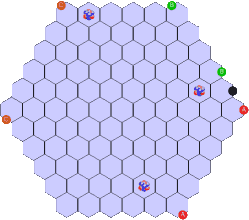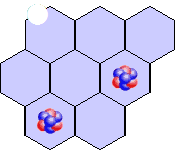 A Rutherford game in progress
A Rutherford game in progress
The game is played on a grid of hexagons. A number of atoms are hidden within the grid, occupying one hexagon each. The object is to deduce the location of all the atoms by observing the behavior of rays fired into the grid.
Marking Rays
Rays are marked by placing a colored dot on the edge where they enter and, if necessary, where they exit. A black dot indicates that the ray was absorbed, a white dot indicates the ray was reflected, and assorted other colors are used for deflections. In the case of a deflection, the dot is also labeled with an identifying letter and an identical dot (with identical label) is placed at the exit point. This makes it easy to find exactly where the ray entered and exited the grid even if other rays have been fired in the meantime.
 Example markings for absorbed rays |
 Example marking for reflected ray |
 Example markings for deflected ray |
Firing Rays
As you move the cursor around the outer edge of the grid, you will see a gray dot appear whenever you are at an entry point. Just click on that gray dot to fire a ray into that entry point. In a moment you will see the result marker(s) appear as described above, indicating the exit point of the ray.
Placing Atoms
Once you have decided on the likely location of an atom, click on the desired hex to place an atom there. To remove an atom, just click on the hex again. You can place and remove atoms as often as you like. A counter to the upper-right of the board will tell you how many atoms still need to be placed.
Solving
After all atoms have been placed, the "DONE" button to the lower-right will become activated. When you click this button you will be asked for confirmation that you have completed your solution. Once confirmed, your proposed arrangement of atoms will be submitted and compared to the actual arrangement.
The actual positions of the atoms will now be indicated with yellow circles. Each atom you have correctly placed will therefore appear with a yellow circle around it. An atom without a circle has been placed on the wrong hex; look for the empty circle marker to see where it should have been.
Scoring
The "Score" field in the upper-left will be updated as you fire rays into the grid; it indicates the total number of markers used so far. This is your base score and will become your final score if you have placed all atoms in their proper positions. Each misplaced atom will incur a penalty equal to the number of atoms on the board, e.g. in a game with 6 atoms each misplaced atom will be penalized 6 points (except as noted below).
Ambiguous Positions
Occasionally you will encounter a position where it is impossible to completely determine the position of one (or sometimes more) atoms. That is to say, a particular atom may potentially be located on two or three possible hexes, but the exact hex cannot be known. Most of these cases occur when an atom is inside a "ring" of other atoms, so that no ray can actually reach the central atom to help fix its exact position.
To prevent unfair penalties in this situation, any of the possible solutions is considered "correct" for scoring purposes. If an atom can really be on two different hexes and there is no way to tell the difference, then you can place the atom on either hex and you will receive no penalty even if you "guess" the wrong one. Note that once the yellow outlines appear indicating the actual locations of the atoms, they may indicate that you have misplaced the ambiguous atom. But that is only to show where the actual atom was, and does not indicate a penalty to your score.
Be very careful however -- in order to receive credit for ambiguous atoms, you must have all other atoms properly placed. If an atom's position can be absolutely determined by ray evidence and you have misplaced it, you will receive the normal penalty for ALL misplaced atoms, even if one of those atoms was misplaced due to ambiguity. In other words, all non-ambiguous atoms must be properly placed or there will be no allowance for ambiguous atoms.
<< Back to Game Page